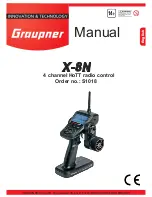
Eng
lish
11
10
Range test
Perform checks for proper operation and range before any use. Secure the model adequately
in place and ensure that no one is in front of the model. Perform a complete functional test on
the ground and execute a complete simulated flight to rule out the possibility of system faults or
problems with the model’s programming.
You must refer to the instructions in the manual of the transmitter. Do not operate your model, ie
when flying or driving, without transmitter or receiver antenna. Ensure a tight fit of the antenna.
Monitoring transmitter and receiver batteries
You must stop running the model to replace or recharge the transmitter’s battery no later than
when, as a result of the drop in battery voltage, the red status LED flashes and an acoustic
warning sounds. Check the status of batteries regularly, particularly the receiver’s battery. Do
not wait for the movements of controlled mechanisms to become noticeably slower. Replace
expended batteries before they cause problems. Always follow the battery manufacturer’s
charging instructions are adhere exactly to charging times. Never leave batteries unattended while
charging. Use your charger only in rooms equipped with a smoke detector for protection.
Warning: Never attempt to charge dry cell (non-rechargeable) batteries (risk of explosion).
All rechargeable batteries must be charged before every use. To avoid short circuiting, first
connect the charger cable’s banana plugs with correct polarity to the charger and then plug the
charger cables into the sockets for the transmitter and receiver batteries.
Disconnect all batteries from the model when it is not to be used for an extended period of time.
Never use defective batteries, damaged batteries or different types of battery cells in combination.
Do not use combinations of old and new batteries or batteries from different manufacturers.
Capacity and operating time
The rule that capacity is reduced with every successive recharging applies to all batteries. Internal
resistance increases at low temperatures, further reducing capacity. As a consequence, the
battery’s ability to supply current and retain its voltage is reduced.
Frequent charging or the use of battery maintenance programs can also result in gradual loss of
battery capacity. Battery capacity should therefore be checked at regular intervals of not more than
every six months and the batteries replaced if performance is found to be significantly deficient.
Purchase only genuine Graupner batteries!
Interference suppression for electric motors
With all conventional electric motors, sparks are generated between the collector and brushes.
Depending on the type of motor involved, this may interfere more or less with the functioning of
the remote control system. The electric motors of a properly built system should therefore include
interference suppression. For electric drive models it is particularly important that every one of its
motors is equipped with proper interference suppression. Interference filters largely suppress such
disturbances and should always be installed. Follow the specific recommendations included in the
motor’s operating and installation instructions.
For further details about interference filters, refer to the Graupner RC main catalog or on the web
at www.graupner.de.
Servo interference filters for extension cables Order No. 1040
The servo interference filter is necessary when an extended-length servo cable is used. This filter
is attached directly to the receiver output. In critical cases a second filter can be attached to the
servo. Using electronic speed controllers Choosing the right electronic speed controller largely
depends on the power of the motor used. In order to prevent an overload or damage to the speed
controller, its current rating should be at least half of the maximum locked-rotor current rating of
the motor. Special caution is necessary in the case of motors referred to as ‘tuning motors’. Due
to the small number of coil windings, such motors can draw a multiple of their rated current in a
Summary of Contents for X-8N
Page 44: ...English 44 Notes...











































